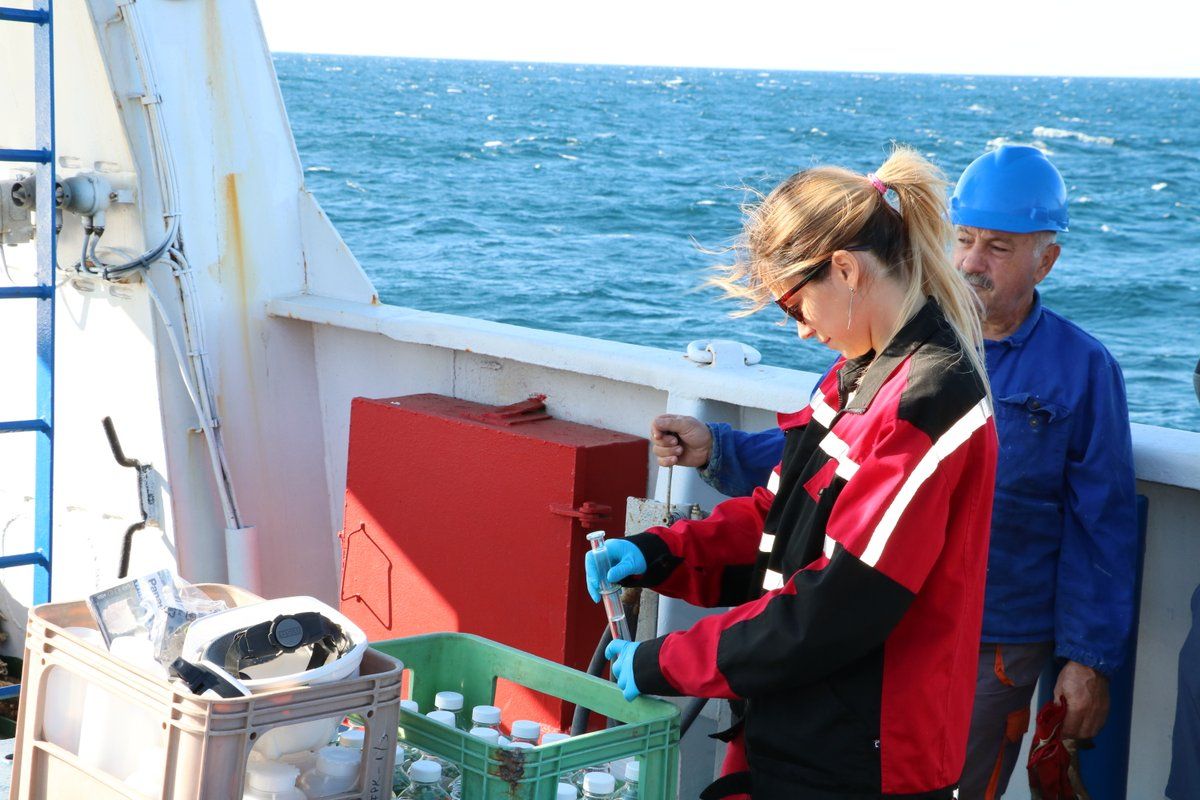Voices from the field
Laura Boicenco
Thousands of citizens monitoring dolphins
The Black Sea is a mosaic of complex interacting ecosystems, rich in natural resources and providing a vital habitat for endangered species. But this treasure is also threatened by the concentration of intense human activities: fishery, contaminated rivers, poorly treated wastewaters, gas, and oil industry exploitations, and of course the recent perforations in the seabed… In the last 30 years, commercially exploitable fish species have dramatically dropped from 26 to 6. The ANEMONE project is fighting against all this. The initiative, funded under the Black Sea Basin ENI CBC programme, has put together a team of experts from Romania, Bulgaria, Ukraine and Turkey to assess the environmental status of the Black Sea at regional level. We have talked to Laura Boicenco, the project manager and a passionate about her region.
What is the final aim of the project?
Our objective was ambitious: delivering a common strategy for the Joint Monitoring of the Black Sea. Each country has its own national programme; Romania and Bulgaria follow the Marine Strategy Framework Directive together with the Black Sea policy and regional plans; whereas Ukraine and Turkey each follow different criteria. Hence the environmental monitoring is rather fragmented. Our purpose was to elaborate a harmonised, common Black Sea Monitoring and Assessment System. We needed a common language to communicate with the different stakeholders and policymakers; in this sense, we have tried to meet in the middle, not to impose the European standards, but to find the best common agreed criteria that work for all and for the Black Sea basin.
What are the main characteristics of the Black Sea? How would you describe it?
 The Black Sea is a complex ecosystem, it has unique features in physical, chemical, and biological terms. Life takes place only on the continental platform, at a depth of a maximum 200 meters. Below the platform, there is a “second sea” comprised of hydrogen sulphide which makes 90% of the waterbody almost lifeless, except for some anaerobic bacteria. Therefore, you have a first sea, characterized by low-salinity, surface waters originating from the rivers where all the life takes place; and a second “layer” of deep, lifeless, high salinity water mass, with its origin in the Mediterranean Sea. This only happens in the Black Sea, no other sea in the world has such characteristics. This also impacts its biodiversity: while the Mediterranean has around 17,000 known species, the Black Sea is home to only 5,000. In this sense, we could say the Black Sea is unique in its own way.
The Black Sea is a complex ecosystem, it has unique features in physical, chemical, and biological terms. Life takes place only on the continental platform, at a depth of a maximum 200 meters. Below the platform, there is a “second sea” comprised of hydrogen sulphide which makes 90% of the waterbody almost lifeless, except for some anaerobic bacteria. Therefore, you have a first sea, characterized by low-salinity, surface waters originating from the rivers where all the life takes place; and a second “layer” of deep, lifeless, high salinity water mass, with its origin in the Mediterranean Sea. This only happens in the Black Sea, no other sea in the world has such characteristics. This also impacts its biodiversity: while the Mediterranean has around 17,000 known species, the Black Sea is home to only 5,000. In this sense, we could say the Black Sea is unique in its own way.
So, you aim at elaborating a joint monitoring programme of the Black Sea: but what are you measuring?

We decided to focus on four areas of action. First, biodiversity: we measured the plankton and other vegetal and animal microscopic organisms, and we observed the marine mammals, mainly dolphins but also other cetaceans. We studied eutrophication levels, a complex phenomenon that takes places when there is an excess of nutrients and organic matter in the water that causes a decrease in oxygen, affecting the living organisms. We also measured the contaminants – everything containing hazardous substances that has a negative influence on the different organisms and, eventually, in the seafood… Lastly, we worked on the marine litter, both the macro and micro-litter. We did field trips and a joint scientific cruise, thanks to which we could gather all the necessary information.
Can you tell us more about the joint scientific cruise?
A team of 17 marine scientists from the four countries embarked on the Romanian research vessel “Mare Nigrum” and for one week carried out samplings of water, sediments, marine organisms, hazardous substances… and did simultaneously observations of the marine cetaceans and litter. The results were the basis for mapping the bottom habitats and enabled us to assess the biodiversity and integrity of the seabed. Later, we tested the different available tools to process the data, analyse them and arrive at comparable results.
What are some of the outcomes of your research?
 We arrived at interesting conclusions. For example, we assessed the presence of contaminants in biota used for human consumption. The information on this topic is rather limited in the Black Sea region so it was important for us to study it. We obtained new data during specific pilot studies on the open sea, coastal areas and in different selected hotspots from Ukraine, Romania, Bulgaria and Turkey. To make results more comparable, we agreed on a common set of contaminants and selected species to be analysed. Overall, 49 samples were taken and examined through a specific assessment tool. The analysis showed that almost 54% of biota samples were affected by hazardous substances ranging from bad, poor and moderate levels of affectations, with varying levels according to sub-regions. Apart from the results, the integration of all the data and the testing of the tools is key to provide answers to policy-makers who often require a simple answer for complex problems. We tested the different tools, analysed the results, decided common indicators and agreed on certain thresholds at regional level to ultimately advise the Black Sea Commission and the environmental authorities of the countries involved.
We arrived at interesting conclusions. For example, we assessed the presence of contaminants in biota used for human consumption. The information on this topic is rather limited in the Black Sea region so it was important for us to study it. We obtained new data during specific pilot studies on the open sea, coastal areas and in different selected hotspots from Ukraine, Romania, Bulgaria and Turkey. To make results more comparable, we agreed on a common set of contaminants and selected species to be analysed. Overall, 49 samples were taken and examined through a specific assessment tool. The analysis showed that almost 54% of biota samples were affected by hazardous substances ranging from bad, poor and moderate levels of affectations, with varying levels according to sub-regions. Apart from the results, the integration of all the data and the testing of the tools is key to provide answers to policy-makers who often require a simple answer for complex problems. We tested the different tools, analysed the results, decided common indicators and agreed on certain thresholds at regional level to ultimately advise the Black Sea Commission and the environmental authorities of the countries involved.
Have you planned the dissemination of the project results?
Yes, we have started communicating our results to the wide scientific community, through different publications in peer-reviewed journals of international reputation, and by participating in multiple scientific conferences, workshops, and symposia. Moreover, our project has shared its results with other initiatives with similar or complementary purposes, such as MARLITTER (also funded by the Black Sea Basin ENI CBC programme) or EMBLAS. We have also prepared deliverables providing an analysis of the main gaps, recommendations and guidelines. These will be soon shared with the Black Sea Commission and the authorities of each partner country.
What about the concept of citizen science? How were the citizens involved?

We wanted to prove that citizens can also provide real, useful and accurate data for the scientists. To do so, we organised workshops in each country on two topics: marine litter and surveillance of cetacean populations. We taught citizens what marine litter was, how it impacted the marine mammals and through field trips they helped us monitor and gather data, literally counting the litter items or the dolphin individuals. Over 240 people were involved in marine litter data collection, 163 citizens were trained on how to monitor the cetaceans and over 2.000 people participated in the monitoring and collection of data on marine mammals. Just by looking at the numbers, it becomes clear that it would have been impossible to reach such large figures involving only professional researchers. Furthermore, when citizens participate directly in our activities, they become more aware, more concerned and can communicate better their needs and claims to the public authorities.
What would you say is the added value of cross-border cooperation?
The Black Sea problems are difficult to manage, many steps need to be taken to deal with its continuous environmental deterioration. This challenge will depend on the scientific collaboration among institutions from different countries and their ability to coordinate. We have contributed by creating a common approach for four of the six riparian countries of the Black Sea, which means the application of common indicators and datasets, to provide a consistent overview of the status of the Black Sea. This was done through cooperation among countries and institutions. My ambition is to get on board all the six countries to really reach an agreement at regional level. But with ANEMONE we are already in the right direction for the blue future of the Black Sea.





















